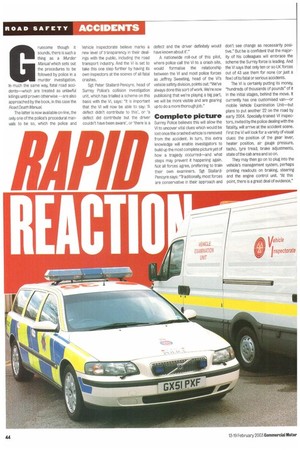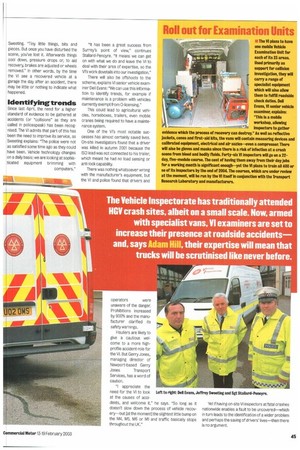G ruesome though it sounds, there is such a thing as
Page 44

Page 45

If you've noticed an error in this article please click here to report it so we can fix it.
a Murder Manual which sets out the procedures to be followed by police in a murder investigation. In much the same way, fatal road accidents—which are treated as unlawful killings until proven otherwise —are also approached by the book, in this case the Road Death Manual.
The latter is now available on-line, the only one of the police's procedural manuals to be so, which the police and Vehicle Inspectorate believe marks a new level of transparency in their dealings with the public, including the road transport industry. And the VI is set to take this one step further by having its own inspectors at the scenes of all fatal crashes.
Sgt Peter Stallard-Penoyre, head of Surrey Police's collision investigation unit, which has trialled a scheme on this basis with the VI, says: It is important that the VI will now be able to say: 'A defect didn't contribute to this', or 'a defect did contribute but the driver couldn't have been aware', or 'there is a defect and the driver definitely would have known about it."
A nationwide roll-out of this pilot, where police call the VI to a crash site, would formalise the relationship between the VI and most police forces as Jeffrey Sweeting, head of the VI's vehicle safely division, points out: "We've always done this sort of work. We're now publicising that we're playing a big part, we will be more visible and are gearing up to do a more thorough job."
Complete picture
Surrey Police believes this will allow the VI to uncover vital clues which would be lost once the crashed vehicle is removed from the accident. In turn, this extra knowledge will enable investigators to build up the most complete picture yet of how a tragedy occurred—and what steps may prevent it happening again. Not all forces agree, preferring to train their own examiners. Sgt StallardPenoyre says: "Traditionally, most forces are conservative in their approach and don't see change as necessarily positive." But he is confident that the majority of his colleagues will embrace the scheme the Surrey force is leading. And the VI says that only ten or so UK forces out of 43 use them for none (or just a few) of its fatal or serious accidents.
The VI is certainly putting its money, "hundreds of thousands of pounds" of it in the initial stages, behind the move. It currently has one customised van—or mobile Vehicle Examination Unit—but plans to put another 22 on the road by early 2004. Specially-trained VI inspectors, invited by the police dealing with the fatality, will arrive at the accident scene. First the VI will look for a variety of visual clues: the position of the gear lever, heater position, air gauge pressure, tacho, tyre tread, brake adjustments, state of the cab area and so on.
They may then go on to plug into the vehicle's management system, perhaps printing readouts on braking, steering and the engine control unit. "At this point, there is a great deal of evidence," Sweeting. "Tiny little things, bits and pieces. But once you have disturbed the scene, you've lost it. Afterwards things cool down, pressure drops or, to aid recovery, brakes are adjusted or wheels removed." In other words, by the time the VI see a recovered vehicle at a garage the day after an accident, there may be little or nothing to indicate what happened.
Identifying trends
Since last April, the need for a higher standard of evidence to be gathered at accidents (or "collisions" as they are called in policespeak) has been recognised. The VI admits that part of this has been the need to improve its service, as Sweating explains: "The police were not as satisfied some time ago as they could have been. Vehicle technology changes on a daily basis; we are looking at sophisticated equipment brimming with computers." "It has been a great success from Surrey's point of view," continues Stallard-Penoyre. "It means we can get on with what we do and leave the VI to deal with their area of expertise, so the VI's work dovetails into our investigation."
There will also be offshoots to the scheme, explains VI senior vehicle examiner Dell Evans: "We can use this information to identify trends, for example if maintenance is a problem with vehicles currently exempt from 0-licensing."
This could lead to agricultural vehicles, horseboxes, trailers, even mobile cranes being required to have a maintenance system.
One of the VI's most notable successes has almost certainly saved lives. On-site investigators found that a driver was killed in autumn 2001 because the ISO lead was not connected to his trailer, which meant he had no load sensing or anti-lock capability.
There was nothing whatsoever wrong with the manufacturer's equipment, but the VI and police found that drivers and operators were unaware of the danger. Prohibitions increased by 900% and the manufacturer clarified its safety warnings.
Hauliers are likely to give a cautious welcome to a more highprofile accident role for the VI. But Gerry Jones, managing director of Newport-based Gerry Jones Transport Services, has a word of caution.
"I appreciate the need for the VI to look at the causes of accidents, and welcome it," he says. "So long as it doesn't slow down the process of vehicle recovery—but [at the moment] the slightest little bump on the M4, M5, M6 or M1 and traffic basically stops throughout the UK."




































































































































































